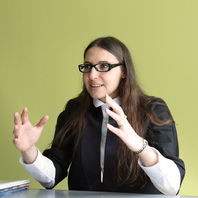![]()
![]()
Research Support Office Research Advancement Division. Tokyo University of Agriculture and Technology
| TEL | +81-42-367-5944 |
|---|---|
| FAX | +81-42-367-5946 |
This program is supported by MEXT’s scientific technology human resource development fee grant, "Program to Disseminate Tenure Tracking System".
Home > Tenured Faculties > Venture Gentiane

Venture Gentiane

| Affiliation | Institute of Engineering |
|---|---|
| Division | Division of Advanced Mechanical Systems Engineering |
| Research field | Robotics |
| Keyword(S) | Robotics, Biomechanics, HRI, Control |
| Url | http://web.tuat.ac.jp/~venture/ |
| Research experience | ・2004/1 - 2004/11: French Nuclear Agency-Robotics division Research associate |
|---|---|
| Educational background | ・MSc 2000/9 University of Nantes |
| Awards | * The latest information is shown at the member's website. |
| Selected papers and publications | * The latest information is shown at the member's website. |
We conduct researches in the field of Robotics. More particularly we are focusing on finding dynamics features that characterize humans and can be understood by robots. We develop formalisms and methodologies to understand human and human motions from their dynamics, as well as to measure humanoids dynamics. This will help in developing more friendly and personalized robotics systems, and will enhance human-robot interaction.
The range of applications includes humanoid robotics, human/robot interction, medical diagnostic support, rehabilitation monitoring, sport science, entertainment... Around the above problematics we are now actively doing research on the following areas (partners):
- Optimal human body modelling for simulation (Toyota Central Laboratory, Nagoya, Japan)
- Identification of the human body dynamics for applications in Biomechanics (Laboratoire Complexite, Innovation et Activites Motrices et Sportives, Paris University, Orsay, France)
- Computation of the contact forces of legged systems, without forceplate, application to rehabilitation and gait evaluation (National Rehabilitation Center, Tokorozawa, Japan)
- Affect recognition from motion and biometrics (Laboratoire de Physiologie et de Perception de l'Action, College de France, Paris, France)
- Systematic identification of dynamics for legged systems
- Adaptative control of robot for optimal and safe interaction with human (Tagawa Lab., TUAT, Tokyo, Japan)
- Marker-less motion capture develpoment (Nakamura Lab., TUAT, Tokyo, Japan)
- Dynamics modeling of human, and muscle identification (INRIA, Montpellier, France & Nakamura Lab., Tokyo University, Japan)
- Identification theory (IRCCyN, Nantes France)
- Evaluation of fatigue from motion (Adaptative Systems Laboratory, Waterloo University, Canada)
- Human foot modelling for robot foot design
The TUAT tenure track program is a unique opportunity for researchers willing to embrace an academic career. Starting from the scratch one's own laboratory is a thrilling experience where what you have learned from your past experiences, and your senior colleague can now be applied with your own colors and in the direction you want. The gradual balance between teaching, research and supervision; the continuous support of the faculty members; the enthusiam of the students are a powerful driving force to high motivation and standing out research outcomes.
Reaching a world top-class level of research in my field and developing a strong multidisciplinary and international framework to keep research going forward and discovering novel approaches and possibilities. Sharing this knowledge with the students and increasing their curiosity and their own ability to excel in their own career.